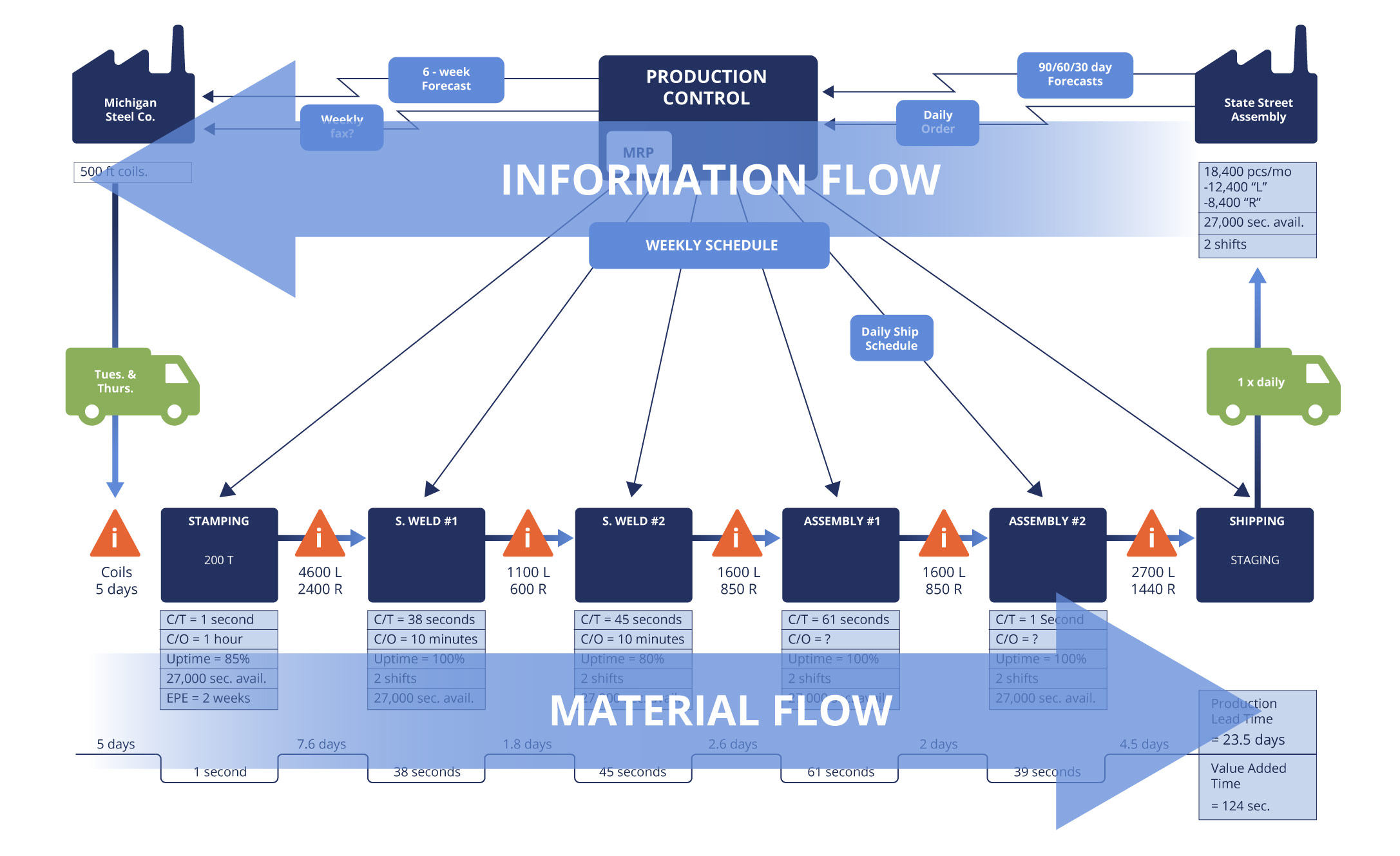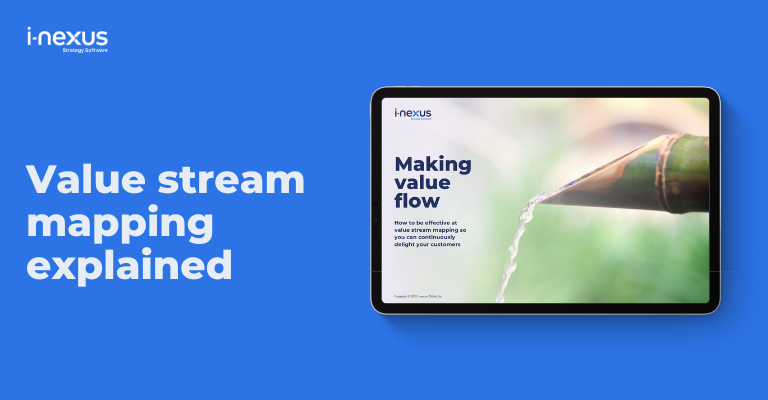What are the differences between current and future state maps? When should you complete them, and how do you use them? Find out in our overview.
Written by: Nigel Richardson
Value Stream Mapping (VSM) is a tool to support planning and executing performance improvement in your organization and is split into two views – current and future state maps.
The two are not mutually exclusive.
In fact, while a current state VSM is worthwhile to gauge your existing processes, it is only by setting out the desired state (the futured / ideal state) that you can know where you aim to be and ensure your process improvements are fruitful.
Indeed, transformation is at the heart of VSM.
Download our free guide to future and current state value stream maps and much more by clicking below:
The current state map
The current state VSM identifies the existing process flow, and allows your team to analyze the related data to identify gaps in process and / or wastage which can be streamlined for efficiencies.
Value Stream Mapping provides you with a single current state map that acts as an incredibly effective way of managing cross-functional problem solving:
- You can highlight areas of customer and internal pain on a single wall, all visible at the same time
- You can build out problem statements and the findings of your root cause analysis in a powerful visual way (hint – look upstream)
- Specific points where you know an improvement needs to be scoped and defined in detail can be added to the relevant points in the current state map (these are often referred to as Kaizen bursts)
- Stakeholders love Value Stream Maps – as the picture starts to build you may find an increasing number of ‘visitors’ of increasing importance in the organization popping their head into the room interested in a quick overview.

So there you have it – on a single wall you have a way of facilitating a large complex, cross-functional group through your traditional improvement process, but in a way that continually reinforces the performance goals of the value stream in relation to customer expectation, flow, and cross-functional efficiency.
Your improvements will often focus on activity within an upstream function for down-stream benefit, attacking the wait time or inventory between process steps or the ‘hand-shake’ points where different functions are handing work off to each other.
From a services perspective, a key source of improvement will not necessarily be to re-engineer how each process step is done.
The focus is more on the gaps in between process steps as above but biased towards how the most steps can be completed in the minimum number of customer contacts.
Regardless of your industry, you can see that Value Stream Mapping as a tool can help you frame and manage a traditional improvement cycle at a much greater cross-functional scale.
However...
There is an opposing school of thought that wants to avoid getting bogged down in the drudgery of the standard improvement dialogue.
The need here is for people to think differently, challenge all assumptions, stimulate thought, provoke challenging debate!
In this scenario, once the current state map is complete you move on to…
The future state map
The future state VSM examines the ideal of how your process should look and work.
This is your opportunity to shortcut the improvement cycle and get straight to exciting, creative, disruptive solution mode.
The goal here is to produce a view of what the future state could be and rely on improvements being defined through the observable gaps between the current and future state.
Beyond ensuring you retain a balanced view to the components of your map (customer, supplier, value delivery and monitoring and control) there is very little prescribed structure to follow here.
Some advice on future state maps
Here are some pointers of advice from my experience that, while not specific to Value Stream Mapping, are relevant to any challenge to deliver a future state:
1) Consider time in your workshop agenda for ensuring that attendees move from Current State to a creative Future state mindset.
My personal go to for this was Joel Barker's “The New Business of Paradigms” video set. Any metaphors you can call out on how a customer experience has been a revolution and shifted paradigms is very powerful.
2) Consider the reality of the influence that you have over this improvement versus the frame of reference of your workshop attendees.
In the past, I have had to deal with a room with a very mixed appetite for big picture thinking.
One of the ways I have found to best deal with this when future state mapping is to split the question in two and develop two different future state maps.
a) What is your future state 1?
-
- Can be delivered with minimal capital investment, a focus purely on people, process, and light technology change
- A timeline of 6 months
b) What is your future state 2?
-
- No constraints on budget or investment required
- A multi-year timeline of delivery
3) If you are limited in creative thought on how to transform rather than incrementally improve parts of your business, consider the acronym of SECAR:
-
- Simplify – can you process improve, take out the waste?
- Eliminate – can you eliminate the need for the process in the first place (link to VOC)?
- Consolidate – can you merge some processes or the capacity that is delivering that?
- Automate – can technology support your delivery?
- Reallocate – should somebody else (e.g. upstream) be doing this work?
Closing thoughts
With your current and future state maps firmly established, this must be underpinned by a culture where learning, measuring, and improving is promoted. Mapping processes and / or collecting data to identify inefficiencies is insufficient without the right culture.
For more information on how you can ensure your VSM and other improvement efforts are successful, read this blog addressing the importance of continuous improvement teams and culture.
Continue learning about continuous improvement
Click here to learn more about continuous improvement, or take a look at these content recommendations:
- Value Stream Mapping Explained: Go beyond the textbook and download this 30+ page guide based on real-life practitioner experience.
- DMAIC v Six Sigma v Lean: Our guide to the steps and tools you'll need when driving process improvement through one of these three methodologies.
- The Leader's Guide to Continuous Improvement: Download this eBook to get a comprehensive overview of how DMAIC, Six Sigma, Lean, PDCA can support your business in finding competitive advantage.
About the author
Nigel Richardson is a continuous improvement expert. His background spans 20 years in business transformation and continuous improvement across retail, pharma, aviation and IT supply chain. He is passionate about supporting organizations to achieve their strategic, transformational and improvement goals, and outperform their peers year after year.
If you’d like to discuss your strategic challenges, connect with Nigel on LinkedIn.



